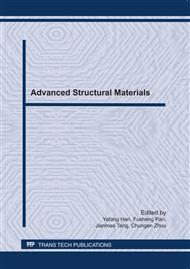p.135
p.140
p.146
p.151
p.157
p.162
p.168
p.176
p.181
High Cycle Fatigue Behavior of Gravity Cast AZ91D Magnesium Alloy
Abstract:
High cycle fatigue behavior of gravity cast magnesium alloy AZ91D were investigated using an up-and-down load method. High cycle fatigue tests were carried out up to 107cycles at a stress ratio R=0.1 and frequency of 90Hz on specimens using a high frequency fatigue machine. Fatigue fracture surfaces of specimens that in the high cycle fatigue tests were also observed using a scanning electron microscope for revealing the micro-mechanisms of fatigue crack initiation and propagation. The results showed that fatigue limit of AZ91D alloy at room temperature is 54.5 MPa under the numbers of cycle to failure Nf=107 conditions using up-and-down method calculation. The fatigue strength of the alloy is about 32% of its tensile strength. The micro-fatigue fracture surface of AZ91D alloy included three representative regions. These regions are fatigue initiation area, fatigue crack propagation area and fatigue fracture area. Fatigue cracks of AZ91D alloy initiate principally at inclusions of alloy surface and subsurface, and propagate along the grain boundary. The fatigue striations of fatigue crack propagation area are not clear. The fatigue fracture of test specimens shows the rupture characteristics of quasi-cleavage.
Info:
Periodical:
Pages:
157-161
Citation:
Online since:
June 2011
Authors:
Price:
Сopyright:
© 2011 Trans Tech Publications Ltd. All Rights Reserved
Share:
Citation:


